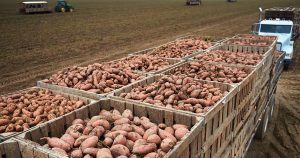The Supply Side: 3,700 acres of sweet potatoes help feed Walmart’s ‘Arkansas Grown’ campaign
by July 19, 2018 1:57 pm 2,594 views

Growing sweet potatoes for Walmart is a full-time, year-round job for Terris and Kim Matthews of Wynne, a city tucked away in Cross County near the northeastern edge of Arkansas. Their venture, Matthews Ridgeview Farms, has grown sweet potatoes commercially for Walmart for 21 years.
Autumn Campbell, sales manager at the farm, said they planted 3,700 acres of sweet potatoes this year and should yield about 1.8 million bushels. Sweet potato farming has been handed down through the Matthews family for 100 years. Terris and Kim, a husband and wife team, branched out on their own in 2006 into what has become Matthews Ridgeview Farms. Terris, a fifth-generation sweet potato farmer, and Kim manage a family business that employs 20 full-time and 50 part-time workers, and around 150 seasonal workers, Campbell said.
Campbell said the contract with Walmart started small more than 20 years ago supplying a few local stores. But with Walmart’s push in recent years to source more local produce, the business has grown to supply six of Walmart’s distribution centers. The farm also sells to Kroger and Harps, but Walmart is its largest customer.
Campbell said Walmart liked the quality of the sweet potatoes, and the family was able to ramp up production around 2007. In 2010, they acquired additional property for warehousing and packing facilities, including cold storage and office space.
“The process of growing sweet potatoes has been passed down from generation to generation in our family,” Terris Matthews states on the company website. “In order to achieve the best quality of sweet potato, we are hands-on during every stage of production. Our dedication and attention to details sets our sweet potatoes apart in both quality and flavor.”
Campbell said the produce industry is ever changing, and the sweet potato market grows each year. The rising popularity of sweet potatoes means the farm is also seeing opportunities to sell more higher margin products such as the microwavable single serving as well as fresh-cut potatoes sought by food processors, Campbell said.
“We are always looking to grow our business in every area,” she added. “This industry changes all the time, and in order to keep ourselves and our customers competitive, we are ready at all times to change and take on new adventures with sweet potatoes.”
GROWING SWEET POTATOES
Growing sweet potatoes is not just a summer job. The company said the seeds — usually small root potatoes — are stored in the warehouse from the fall to the spring and are bedded in March.

The company said field planting of the 3,700 acres usually begins in mid-May. Once the slips have been planted, they begin to cultivate stronger roots to absorb the nutrients and moisture for growth. Over the next 100 to 120 days, the slips will continue to grow and produce sweet potatoes until they are harvested in the fall.
Harvest begins when the sweet potatoes are the appropriate size. This is usually the beginning of September. The company said its sweet potatoes are mechanically harvested, graded in the field and put into wooden bins. The sweet potatoes are transferred from the field to the warehouse where all bins are tagged for sizing, field, variety and harvest dates for traceability purposes.
After the sweet potatoes are brought to the warehouse, they are stored in temperature-controlled coolers. The company adds heat to help the curing process, and cooler temperatures are used for storage to ensure the best quality for a year-round supply.
WALMART COMMITMENT
When asked if there’s anything the public should know about farms that supply Walmart, Campbell said the retailer insists on farms having a good food safety program in place, as well as the means to keep quality consistent and relationships genuine.
In June, Walmart grocery boss Charles Redfield said the retailer continues to be committed to purchasing and highlighting local grown produce and products in its stores. A new promotional push to support local products began Memorial Day and will run through the summer.
New signage is up in stores around the region, and Walmart said it will continue to highlight products made or produced close to home because customers often prefer them. Local store management is given the discretion as to how they feature the local produce, but the initiative came out of the corporate offices.
Last summer, Walmart announced the Arkansas Grown program with the state to promote local produce in stores. Walmart said it would double its locally grown produce sales in the U.S. by 2025. Walmart did not provide recent numbers when asked about progress toward the goal. But through 2015, sales of locally-sourced produce had risen to $825 million, according to the retailer. If Walmart remains on track to hit its goal, the locally-sourced produce sales should reach $1.65 billion by 2025.
Cindi Marsiglio, vice president of U.S. manufacturing and sourcing at Walmart U.S., recently told the Northwest Arkansas Business Journal that sourcing food close to home ensures the freshest quality and keeps prices lower because it shortens the supply chain and transportation costs.
“It’s a more sustainable way to do business, and our customers love it when they know they are supporting local businesses through their purchases,” she said.
–––––––––––––––––
Editor’s note: The Supply Side section of Talk Business & Politics focuses on the companies, organizations, issues and individuals engaged in providing products and services to retailers. The Supply Side is managed by Talk Business & Politics and sponsored by Propak Logistics.
